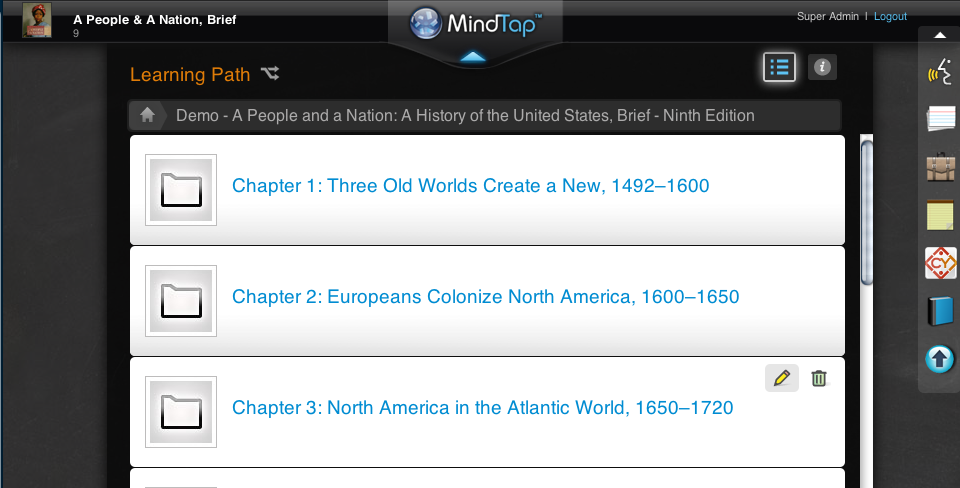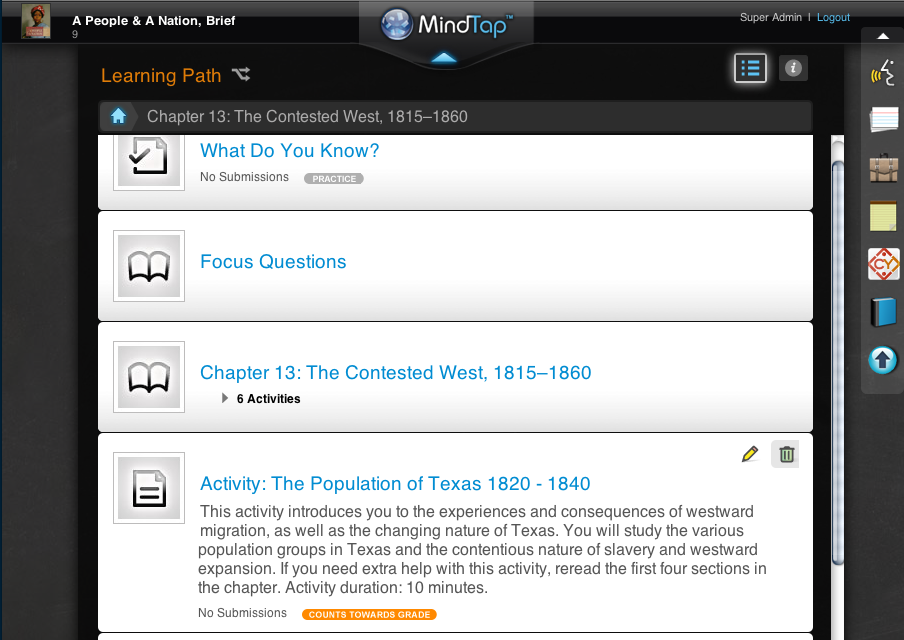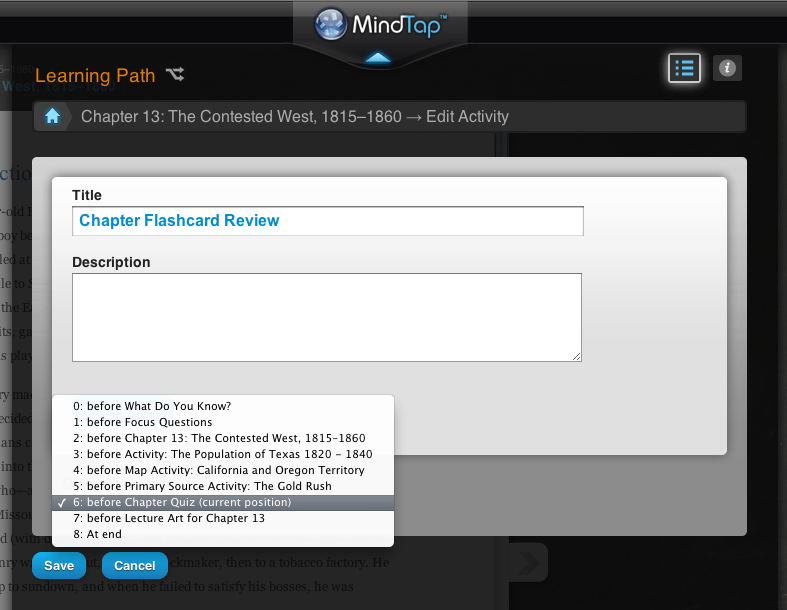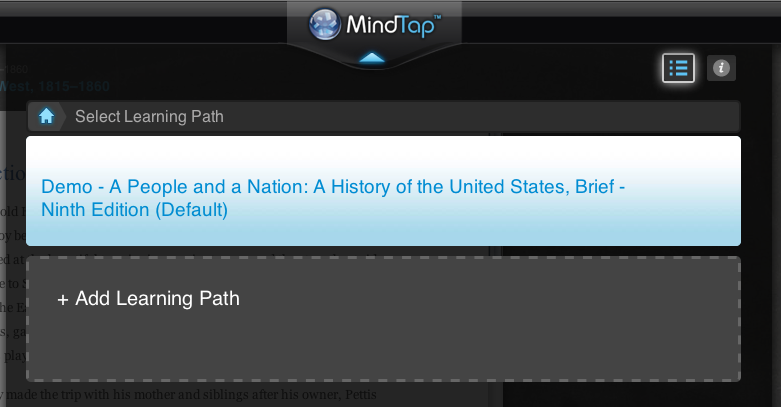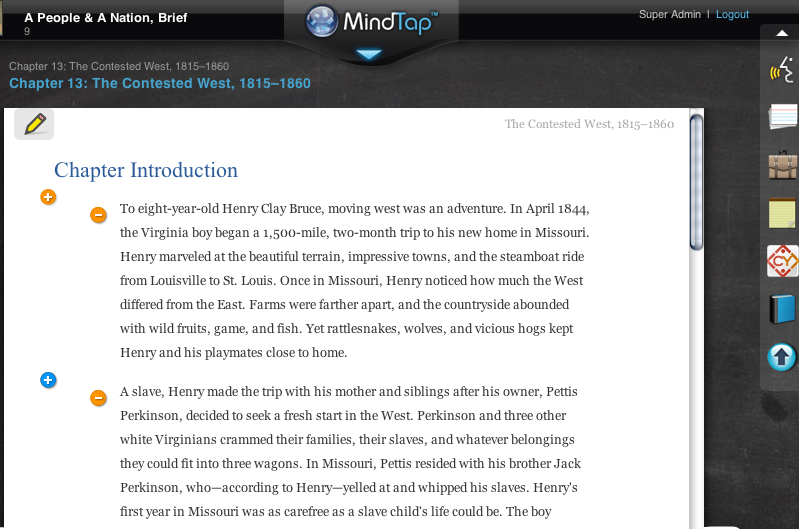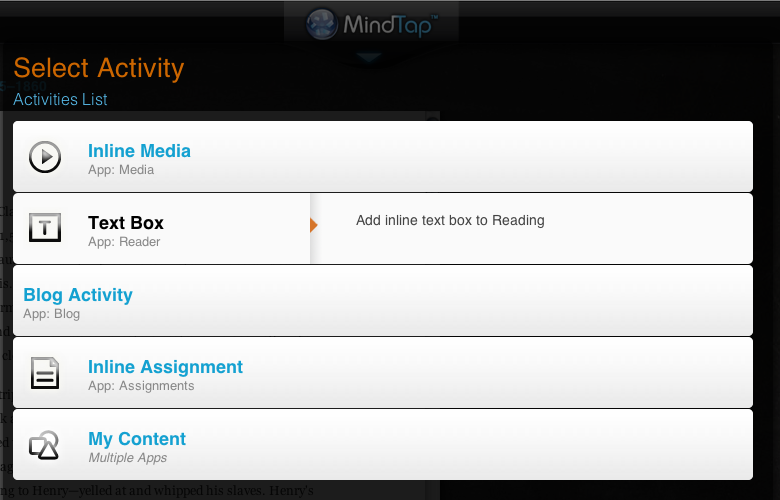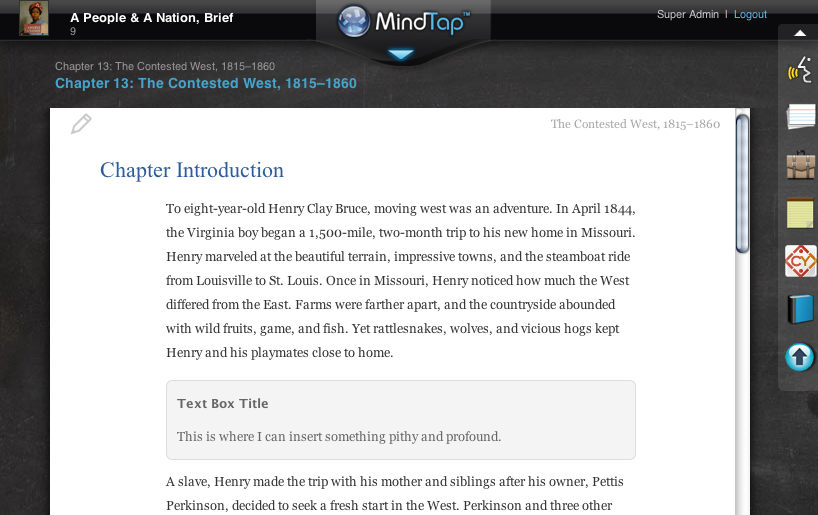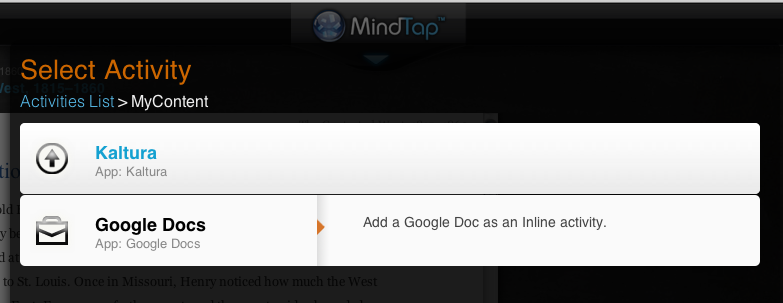In my last post, I wrote about a new application category that has grown out of the need for textbook companies to re-imagine their traditional product for the Digital Age. I suggested that the perspective that these companies bring to digital learning environments contrasts markedly to those of traditional LMS developers. Consequently, they are bringing some novel approaches and innovation to the space. As you might imagine, content is at the heart of textbook publishers’ thinking, since it is at the heart of their business model. This post will specifically explore some of the wrinkles that textbook publishers face when educational content goes digital and how they are dealing with it in their platform designs.
Ripping Paper
From a textbook publisher’s perspective, there are a couple of problems with the traditional analog product (beyond the economics and resource consumption of manufacturing and shipping massive bricks made out of dead trees). First, teachers tend to want to cherry pick from the content in the book. They may like chapters 1-8, 11-13, and 15, but want to skip chapters 9-12, 14, and 16-22. And maybe they only want to use half of chapter 12. On top of that, for at least as long as the photocopier has existed, teachers have been heavily supplementing their content with other materials. As teachers use less and less of the publisher-provided materials and more and more of other materials, the danger (to publishers) is that the book will increasingly be seen as overpriced at best and completely superfluous at worst. One of the ways that textbook publishers have traditionally responded to that threat is by bundling more and more content with the core product. Each edition has a few more chapters, another workbook, a couple of more online quizzes, and more material on the web site. Along with this increase in volume of content has come an increase in cost. Here’s a graph by Mark Perry, a University of Michigan economist, showing the increase in textbook costs from 1978 to 2009:
Note that textbook costs have risen faster even than medical care, eclipsed only by the rise in tuition costs. Meanwhile, the percentage of content provided that is actually used by the students is dropping, in large part because the publishers keep throwing more into every edition. The net perception on the part of the students is that they are paying a lot of money for content they mostly don’t use. Custom book development offers some relief from this problem in some cases, but it’s limited.
Going digital affords publishers an opportunity to change the dynamic. If they can enable instructors to rearrange, remove, add, and change content from the book, then students will actually use and find value in a much higher percentage of what they are paying for. And because the content will be structured in a way that’s consistent with how the instructor is teaching, students won’t have to do a lot of jumping around to find what they’re looking for. They will have a streamlined and focused experience. In my first post, I mentioned MindTap, Inkling, and Kno as digital textbook platforms. I’ll add Macmillan’s DynamicBooks and Flat World Knowledge’s MIYO (Make It Your Own) to the list. (There are also a couple of lesser known startups out there that I may write about if I learn more about them and can clear the time.) I would put MindTap and Inkling in a different application category than the others, for reasons that I’ll get into in my next post. But for the purposes of the content discussion, they all can be evaluated together—with the exception of Kno, which does not yet seem to have implemented any content editing features.
Folding Paper
Because of copyright considerations, it’s easier for a publisher to think about re-ordering or deleting than it is for them to think about adding or changing. The exception to that rule is a publisher like Flat World Knowledge that focuses solely on open content.
I’ll start with the baseline of content deletion first. I’m going to use MindTap as the primary example since that’s the one I know and can access for screen shots. (This is all coming from the subset of MindTap functionality known as Reader; I’ll be writing more about other aspects in the next post in the series.) Deleting at the chapter level is the absolute simplest place that these products will tend to start. If you only use 15 out of 35 chapters, why not get rid of the other 20? They’re just in the way. In MindTap, the rough equivalent of a chapter is something called a “Learning Unit”—although in books that are being converted to MindTap rather than created for it, Learning Units are often still referred to “chapters” for consistency’s sake—and it lives on a “Learning Path.”
A teacher can remove a Learning Unit by clicking on the garbage can icon, which brings up a delete dialog:
All of these products (again, with the exception of Kno) have chapter deletion functionality. Inkling has additionally made it an economic feature. Students pay by the chapter and can buy the book one chapter at a time as they need the content.
Of course, instructors may want finer grained control over what gets deleted. Maybe they want to delete just a section of a chapter, or even just a paragraph. In MindTap, Learning Units are divided into Learning Activities, each of which may be deleted just like a Learning Unit can:
Even within a Learning Activity, teachers have the ability to delete content at a paragraph level by putting the system into edit mode and clicking on the minus icon:
Images, videos, and other assets can also be deleted this way.
Inkling does not seem to support deletion below the chapter level. MIYO and DynamicBooks both do. In fact, MIYO goes a step further and lets you delete (and edit) down to the sentence level. It’s not entirely clear whether DynamicBooks (which looks like it’s based on VitalSource technologies) allows sentence-level deletion, but it appears to.
Shuffling Paper
Sometimes teachers also want to re-order the content in the book. MindTap allows teachers to re-order Learning Activities and Learning Units on the Learning Path:
MIYO and DynamicBooks both also offer this feature. Inkling does not appear to support it.
MindTap even has the ability for teachers to create multiple paths through the content that are available to the students at the same time. For example, they could create a “quick study” path in addition to the main text. They just add a new Learning Path:
Writing Paper
Moving textbook content around and removing bits you won’t use is good, but being able to add useful content or change the content to make it more useful is better. At this level of feature richness, we’re down to three products: MindTap, MIYO, and DynamicBooks. Inkling and Kno have reached the end of their capabilities in this dimension, as of this writing. This is also where we come to a significant divergence in approach driven by copyright. MIYO allows for any and all content to be edited, including changing the actual text. All of their books are under a Creative Commons license that allows derivatives, so this is a capability that they are highlighting as a differentiator. It’s hard to tell where DynamicBooks comes down on this issue, although their video (shown later in this post) seems to indicate that all content can be edited as well. Since authors would have to either cede copyright to the publisher or grant permission to edit in order for this capability to be available, that may explain why their title catalog appears to be limited to one book, despite the fact that they’ve been around for a while. MindTap takes a different approach. Teachers may delete and re-order the publisher’s content, but they may not edit publisher-provided content (if by “edit” you mean change the words of the written text). Instead, they can insert their own content by clicking on the plus sign in the text:
This brings up a dialog where they can insert either publisher-provided content or their own:
They could, for example, insert a text box. Choosing that option brings up a dialog where they can insert their own content:
The result looks like this:
Wrapping Paper
Of course, teachers may also want to insert content that lives elsewhere. It might be a slide presentation that they have stored in their Google Docs account, or a YouTube video, or a blog post, or set of Creative Commons-licensed supplemental materials from Connexions. All of these materials have permanent homes on the web outside of the nextbook platform. Rob Reynolds refers to this as “containerless learning content.” I agree with Rob’s contention that this kind of content insertion will be far more pervasive and important than inserting content internal to the book content, for several reasons. First, it reduces lock-in on learning technology platforms while increasing convenience for instructors. If you load all your content into a platform, then you have to move it when you migrate to a new LMS or a different publisher’s nextbook platform. If, on the other hand, you have it stored wherever you normally keep your content long-term—whether it’s Google Docs, SlideShare, Flickr, Vimeo, WordPress, your own web server, etc.—then it stays with you no matter what educational technology platform you happen to use. Second, when you make a local copy of something, you diminish your ability to do analytics on its usage and effectiveness. If you’re teaching biology, wouldn’t you like to know which YouTube videos are being used most often to teach mitosis across the world? And wouldn’t you like to know which of those videos seems to have measurable impact on learning outcomes? We have a ways to go before we can get to that level of capability, but we will certainly never get there if we don’t maintain a canonical identifier for the resource that enables us to know when it’s being used across teachers, courses, learning objectives, institutions, and educational technology platforms. A URL does that for us. The web is by far the most effective learning object repository ever built in that regard. If you start ingesting content into siloed systems, you break that capability. So what you want to do is provide a system that can wrap those external resources and provide learning context without actually moving them anywhere. When we get to this level of publishing functionality, MIYO drops out of the running (for now). It’s down to MindTap and DynamicBooks. In MindTap, when you go to add a resource, you can add a Google Doc just as easily as you can add a text box:
Doing so links the teacher to his or her Google Docs account. Any content in that account can be inserted inline in the text:
Once teachers can delete content, reorder content, and add new content at the paragraph level (including lots of external content in a variety of media formats), the effective value gap between that and being able to edit publisher-provided content at the sentence level becomes unclear. Teachers can radically alter the materials being presented to the students in in either case. Anyway, DynamicBooks allows for support of containerless content through the more traditional user experience of surfacing everything in a rich text editor. This is flexible and familiar, but I will argue in my next post that it leads down a road that is ultimately limited. To take this product category to the next level, you need to think beyond the text editor to an app model. I’ll address that topic in my next post.
In the meantime, since I wasn’t able to provide screen grabs for products other than MindTap, you might find it useful to watch these MIYO and DynamicBooks product videos, which cover their editing capabilities. (The actual MIYO demonstration starts about halfway through the video.)

